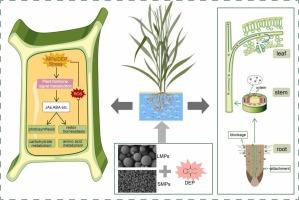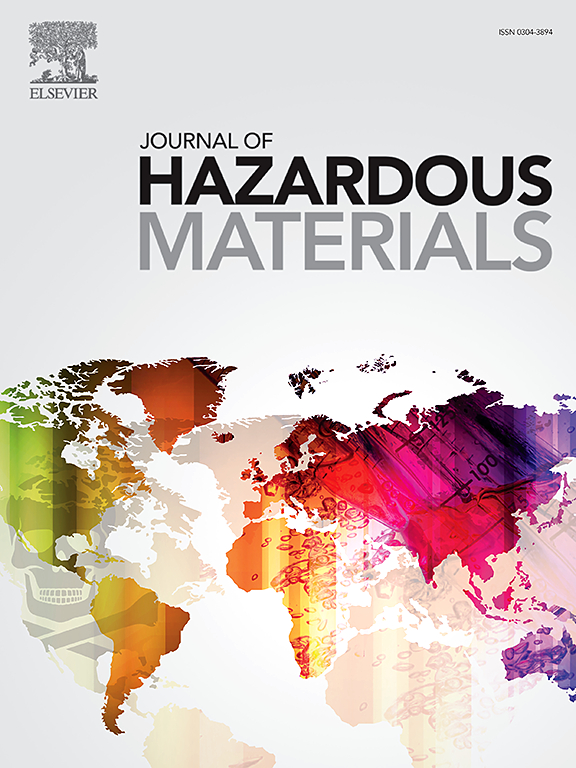揭示不同粒径的微塑料对黑麦(Secale cereale L.)中邻苯二甲酸二乙酯(DEP)的生物利用率和植物毒性
IF 12.2
1区 环境科学与生态学
Q1 ENGINEERING, ENVIRONMENTAL
引用次数: 0
摘要
尽管微塑料(MPs)和邻苯二甲酸二乙酯(DEP)对人类暴露有重大影响,但人们对广泛分布的微塑料(MPs)和邻苯二甲酸二乙酯(DEP)如何与农作物相互作用的了解仍然有限。我们利用生理学、转录组学、吸附动力学和计算化学来评估黑麦对两种尺寸的微塑料(200 nm 和 5 μm)和邻苯二甲酸二乙酯(DEP)的分子反应。研究结果系统地强调了 MPs 和 DEP 的潜在生态风险,生态毒性排名如下:CK(对照检查);LMPs;SMPs;DEP;LMPs+DEP;SMPs+DEP。荧光和扫描电子显微镜显示了 SMP 在黑麦中的迁移能力及其破坏叶片细胞的潜力。DEP 增加了 MPs 的负电荷,从而增强了黑麦对其的吸收。水培法中 MPs 对 DEP 的吸附降低了 DEP 在黑麦中的生物利用率(18.17%-46.91%)。分子对接研究表明,DEP 与叶绿素、超氧化物歧化酶和谷胱甘肽 S 转化酶蛋白的活性位点相互作用。转录组分析发现,在暴露于 MPs 和 DEP 的黑麦中,与丝裂原活化蛋白激酶信号转导、植物激素和抗氧化系统有关的基因明显上调,这与生理变化相关。这些发现加深了人们对 MPs 如何在黑麦中积累和转移的理解,而它们对 DEP 的吸附又提出了具有更大环境风险的作物安全问题。本文章由计算机程序翻译,如有差异,请以英文原文为准。

Revealing the bioavailability and phytotoxicity of different particle size microplastics on diethyl phthalate (DEP) in rye (Secale cereale L.)
Understanding how widely distributed microplastics (MPs) and diethyl phthalate (DEP) interact with crops remains limited, despite their significant implications for human exposure. We used physiology, transcriptomics, adsorption kinetics, and computational chemistry to assess rye’s molecular response to two sizes of MPs (200 nm and 5 μm) and DEP, both individually and in combination. Findings systematically highlight potential ecological risks from MPs and DEP, with ecotoxicity ranking as follows: CK (Control Check) < LMPs < SMPs < DEP < LMPs+DEP < SMPs+DEP. Fluorescence and scanning electron microscopy revealed SMP’s translocation ability in rye and its potential to disrupt leaf cells. DEP increased the negative charge on MPs, which enhanced their uptake by rye. DEP adsorption by MPs in hydroponics reduced DEP bioavailability in rye (18.17-46.91%). Molecular docking studies showed DEP interacted with chlorophyll, superoxide dismutase, and glutathione S-transferases proteins’ active sites. Transcriptomic analysis identified significant up-regulation of genes linked to mitogen-activated protein kinase signaling, phytohormones, and antioxidant systems in rye exposed to MPs and DEP, correlating with physiological changes. These findings deepen the understanding of how MPs can accumulate and translocate within rye, and their adsorption to DEP raises crop safety issues of greater environmental risk.
求助全文
通过发布文献求助,成功后即可免费获取论文全文。
去求助
来源期刊

Journal of Hazardous Materials
工程技术-工程:环境
CiteScore
25.40
自引率
5.90%
发文量
3059
审稿时长
58 days
期刊介绍:
The Journal of Hazardous Materials serves as a global platform for promoting cutting-edge research in the field of Environmental Science and Engineering. Our publication features a wide range of articles, including full-length research papers, review articles, and perspectives, with the aim of enhancing our understanding of the dangers and risks associated with various materials concerning public health and the environment. It is important to note that the term "environmental contaminants" refers specifically to substances that pose hazardous effects through contamination, while excluding those that do not have such impacts on the environment or human health. Moreover, we emphasize the distinction between wastes and hazardous materials in order to provide further clarity on the scope of the journal. We have a keen interest in exploring specific compounds and microbial agents that have adverse effects on the environment.
 求助内容:
求助内容: 应助结果提醒方式:
应助结果提醒方式:


